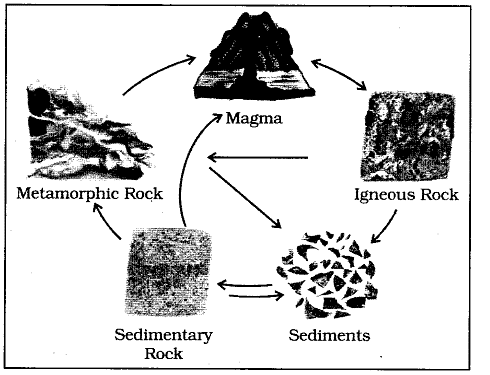Class 7 Geography Chapter 2 Question Answers - Inside Our Earth
Q1. Into how many types the layers of the earth is divided?
Ans: The earth consists of three layers:
- Core (inner core and outer core)
- Mantle (upper and lower mantle)
- Crust (continental and oceanic crust)
Q2. How is a sedimentary rock made?
Ans: Rocks roll down, crack, and hit each other and are broken down into small fragments. These smaller particles are called sediments. These sediments form sedimentary rocks.
Q3. What are intrusive igneous rocks? Give an example.
Ans: Intrusive igneous rocks form when molten magma cools slowly deep within the Earth's crust. This slow cooling allows the formation of large mineral grains.
- Granite is a common example of an intrusive igneous rock.
- Granite is often used for making grinding stones, which are used to prepare spices and grains.
Q4. What do you understand about uppermost layer of the earth? Briefly describe.
Ans: The uppermost layer of the Earth is known as the crust. Key features include:
- It is the thinnest layer of the Earth.
- Its average depth is about 40 km.
- On continental masses, it is approximately 35 km deep.
- On ocean floors, it is only about 5 km deep.
Q5. What are extrusive igneous rocks? Give an example.
Ans: Extrusive igneous rocks are formed when molten lava erupts onto the Earth's surface. As the lava cools quickly, it solidifies into rock. Key characteristics include:
- They have a fine-grained structure.
- An example of extrusive igneous rock is basalt.
- The Deccan Plateau in India is primarily composed of basalt.
Q6. Describe various types of rocks.
Ans: Rocks are of three types, which can be described as under:
(i) Igneous rocks: When the molten magma cools, it becomes solid. Rocks thus formed are called igneous rocks. They are also called primary rocks. Igneous rocks further can be divided into two types- intrusive and extrusive rocks.
(a) Intrusive igneous rocks: Sometimes the molten magma cools down deep inside the earth’s crust. Solid rocks so formed are called intrusive igneous rocks.
(b) Extrusive igneous rocks: When molten lava comes on the earth’s surface, it rapidly cools down and becomes solid. Rocks formed in such a way on the crust are called extrusive igneous rocks.
(ii) Sedimentary rocks: When rocks roll down, crack, and hit each other and are broken down into small fragments, these smaller particles are called sediments. These sediments are transported and deposited by wind, water etc. These loose sediments are compressed and hardened to form layers of rocks. These types of rocks are called sedimentary rocks.
(iii) Metamorphic rocks: Igneous and sedimentary rocks can change into metamorphic rocks under great heat and pressure. For example, clay changes into slate and limestone into marble.
Q7. Describe the Rock cycle.
Ans: The rock cycle is a continuous process where one type of rock transforms into another.
It involves several stages:
- Igneous rocks form when molten magma cools and solidifies.
- These igneous rocks can break down into small particles, which are transported and deposited to create sedimentary rocks.
- When igneous and sedimentary rocks are subjected to heat and pressure, they change into metamorphic rocks.
- Under extreme heat and pressure, metamorphic rocks can melt, forming molten magma.
- This molten magma can cool again, solidifying into new igneous rocks, thus completing the cycle.
This cyclical process illustrates how rocks continuously change from one form to another, showcasing the dynamic nature of our planet.
|
63 videos|371 docs|46 tests
|
FAQs on Class 7 Geography Chapter 2 Question Answers - Inside Our Earth
| 1. What are the main layers of the Earth? |  |
| 2. How do we know what the inside of the Earth is like? |  |
| 3. What is the significance of the Earth's mantle? |  |
| 4. What materials make up the Earth's core? |  |
| 5. How does the Earth's structure affect life on the surface? |  |





















